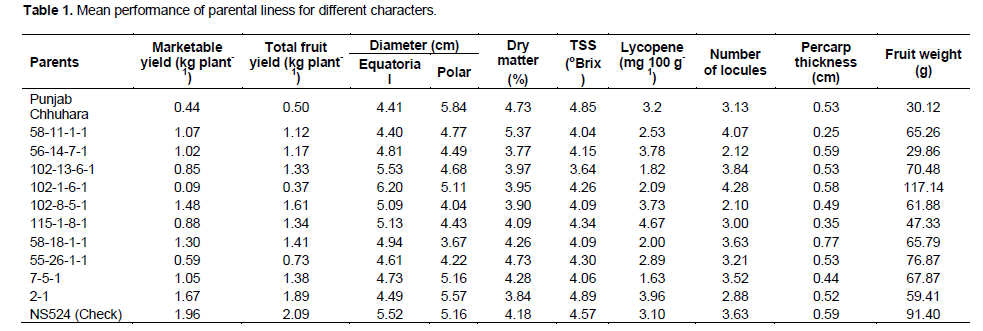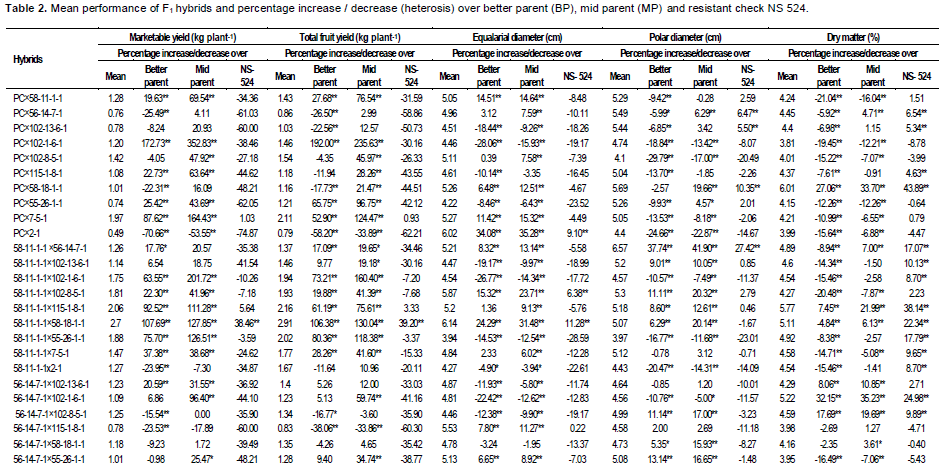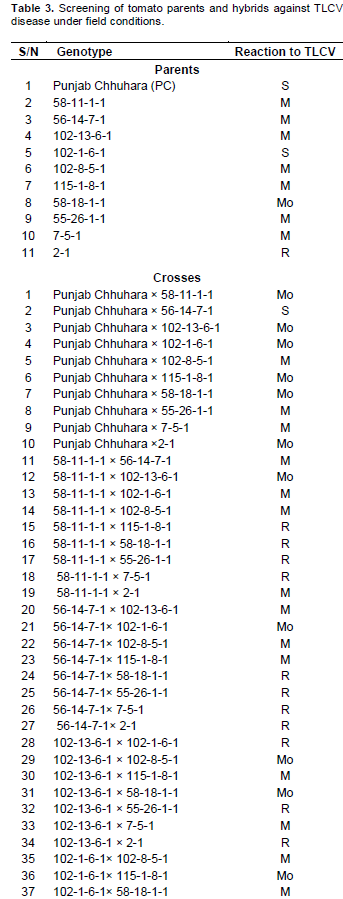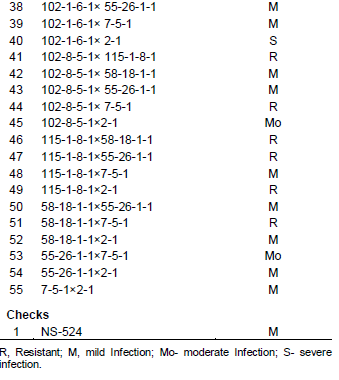Tomato (Solanum lycopersicum L.) is a major vegetable crop grown throughout the world including tropical, subtropical and temperate regions. On global basis, it is planted on 4.4 million hectares with a total production of 161.79 million tonnes (Anonymous, 2012). India is the third largest tomato producer in the world after China and USA, accounting for about 8% of the world tomato production. It is cultivated over an area of about 0.905
million hectares with the total production of 19.10 million tonnes and productivity of 21.10 t ha-1 (Anonymous, 2013).
Leaf curl virus is a serious disease of tomato and its incidence can reach up to 100% with yield losses often exceeding 90% (Saikia and Muniyappa, 1989). Tomato cultivation, especially in autumn season in North India and in summer season in South India is adversely affected due to high incidence of TLCV. The disease is caused by different species of genus Begomovirus (Family Geminiviridae), which are transmitted by whitefly (Bemisia tabaci Genn.). Managing the disease with pesticides has been a difficult task because of the rapid development of pest resistance to most insecticides (Horowitz et al., 2005). In recent years, the hybrid cultivars of tomato have become very popular with the growers due to their superior per se performance, which is manifested due to better plant vigour, faster growth and development, earliness, increased productivity and higher levels of resistance to biotic and abiotic stresses (Yordanov, 1983). Punjab Agricultural University has recommended three hybrids of tomato viz., TH 2312, TH 802 and TH 1 for cultivation in the state. However, all the three hybrids are susceptible to TLCV and are, therefore, not suitable for cultivation in the rainy season. Recently, the university has developed some breeding lines possessing high degree of resistance to TLCV. These lines will serve as the potential source for the development of TLCV resistant hybrids suitable for cultivation in rainy season.
Choice of parents for hybridization is one of the critical and most important tasks for plant breeders. The common approach for selecting the parents based on per se performance does not necessarily lead to desired results. Therefore, the present investigation was undertaken to identify tomato hybrids resistant to TLCV and suitable for cultivation in rainy season.
The present investigation was carried out at the Department of Vegetable Science, Punjab Agricultural University Ludhiana, India during 2011-12 and 2012-13. The material for the present study comprised of eleven parents viz., Punjab Chhuhara, 58-11-1-1 , 56-14-7-1, 102-13-6-1, 102-1-6-1, 102-8-5-1, 115-1-8-1, 58-18-1-1, 55-26-1-1, 7-5-1, 2-1 along with one resistant check hybrid NS-524. Fifty-five F1 crosses (excluding reciprocals) involving 11 parents were made in a diallel fashion during February-March 2012. The parents, except Punjab Chhuhara, were selectively chosen for their resistance to TLCV. The experimental material comprising 55 F1 hybrids, 11 parental lines and check NS-524 were sown and raised in plastic trays in July and transplanted in August in an Augmented Randomized Block Design. All the cultural practices were followed as per the recommendations in Package of Practices for Vegetable Crops (Anonymous, 2013a). To increase inoculum pressure, one row of TLCV susceptible cv. Punjab Chhuhara was planted after every fifth row of the experimental plots. Plants were examined at weekly intervals for TLCV symptoms. Disease spread and the severity of symptoms were recorded according to the disease severity scale described by Muniyappa et al. (1991). Data for various horticultural traits were recorded from five randomly selected plants excluding border plants. Observations were recorded on 10 economic traits viz., marketable yield (kg plant-1), total fruit yield (kg plant-1), equatorial diameter (cm), polar diameter (cm), dry matter (%), total soluble solids (%), lycopene (mg 100-1 g of fresh weight), number of locules per fruit, pericarp thickness (cm) and average fruit weight (g). Mean performance of parents for different characters is presented in Table 1.

There were significant differences in the performance of parents, hybrids and checks for fruit yield, horticultural traits and TLCV resistance. The genetic differences exhibited by the hybrid progenies could be exploited through heterosis breeding with the identification of superior performing F1 hybrids.
Estimation of heterosis
The available literature on heterosis in tomato provided evidence that this phenomenon is not limited to cross-pollinated crops. One of the theories of this performance was that natural cross-pollination predominated within the wild forms of tomato in the centers of their origin. Therefore, crosses between tomato lines might be considered as F1 between inbred lines of a species, which is naturally cross-pollinating. The exploitation of heterosis phenomenon can prove a potential tool in the hands of plant breeders for the improvement of this crop.
The results pertaining to mean performance and percent heterosis over better parent, mid parent and NS-524 are reported in Table 2.
Marketable yield (kg plant-1)
Four cross combinations viz., 102-8-5-1 × 7-5-1, 102-13-6-1 × 55-26-1-1, 58-11-1-1×58-18-1-1 and 102-13-6-1 × 2-1, exhibited positive heterosis over NS-524. These crosses outperformed the resistant check NS 524 by 13.85, 17.44, 38.46 and 66.15%, respectively. Cheema et al. (1996) also reported significant positive heterosis for marketable yield.
Total fruit yield (kg plant-1)
Four cross combinations, namely 102-13-6-1 × 55-26-1-1, 102-8-5-1 × 7-5-1, 58-11-1-1 × 58-18-1-1 and 102-13-6-1 × 2-1, were identified as promising for total fruit yield. These crosses outperformed the resistant check NS-524 by 14.81, 30.12, 39.20 and 63.12%, respectively. Heterosis for fruit yield was also reported by Dod and Kale (1992), Kumar et al. (1995), Chaudhary and Malhotra (2001), Tiwari and Lal (2004), Mahendrakar et al. (2005) and Premalakshme et al. (2005) and Gaikwad et al. (2009).



Equatorial diameter (cm)
Four cross combination, that is, Punjab Chhuhara × 2-1, 102-8-5-1 × 7-5-1, 102-13-6-1 × 115-1-8-1, 58-11-1-1 × 58-18-1-1 and 115-1-8-1 × 55-26-1-1, were identified as promising for equatorial diameter. These crosses outperformed the resistant check NS 524 by 9.10, 10.73, 11.10, 11.28 and 19.07%, respectively. Kumar et al. (2006), Ahmad et al. (2011) and Shende et al. (2012) reported heterotic hybrids for equatorial diameter.
Polar diameter (cm)
The potential tomato fruit shape and size depend on cell number established in pre-anthesis stage but the final fruit size depends on the rate and duration of cell enlargement. Seed number and competition among fruits also affect the final fruit shape. Five cross combinations viz., 115-1-8-1 × 58-18-1-1, 115-1-8-1 × 7-5-1, 115-1-8-1 × 55-26-1-1, 58-11-1-1 × 56-14-7-1 and 102-1-6-1 × 115-1-8-1, were identified promising for polar diameter and outperformed the resistant check NS-524 by 15.59, 19.46, 25.86, 27.42 and 32.07%, respectively. Ahmad et al. (2011) and Shende et al. (2012) reported significantly positive heterosis for this trait.
Dry matter (%)
The importance of fruit dry matter content is well
recognized for the preparation of various products made from tomato. The cross combinations namely, 56-14-7-1 × 102-1-6-1, 115-1-8-1 × 58-18-1-1, 102-1-6-1 × 55-26-1-1, 58-11-1-1 × 115-1-8-1 and Punjab Chhuhara × 58-18-1-1, were identified as promising for dry matter and outperformed the resistant check by 24.98, 15.16, 18.03, 38.14 and 48.89%, respectively. Significant heterosis for dry matter was earlier reported by Gaikwad et al. (2009) and Garg and Cheema (2011).
Total soluble solids (°Brix)
The major constituents of TSS are glucose, fructose and sucrose. These parameters are of
major interest of the processing industries as cultivars with high soluble solids give more finished product per unit weight of raw fruit. Three cross combinations exhibited significant heterosis over NS-524. The cross combinations, that is, 102-13-6-1 × 2-1, 115-1-8-1 × 58-18-1-1 and 102-1-6-1 × 58-18-1-1, were identified as promising for total soluble solids and outperformed the resistant check NS-524 by 12.31, 17.35 and 19.32%, respectively. Heterosis for this trait was also observed by Gunasekera and Parera (1999), Anitha et al. (2007), Sharma and Thakur (2008) and Dod et al. (1995). However, Wang et al. (1998) noticed that hybrids were intermediate between their parents for total soluble solids.
Lycopene content (mg 100 g-1)
Increased lycopene content has proven nutritional value as an antioxidant, which is associated with a low incidence of certain forms of human cancer. Recently, high-lycopene tomatoes have been sold as specialties in the fresh market. High lycopene content imparts dark red colour to the tomato, which is preferred for table as well as processing purpose. The hybrid combinations, that is, 58-11-1-1 × 55-26-1-1, 102-13-6-1 × 102-8-5-1, 102-8-5-1 × 58-18-1-1, 56-14-7-1 × 55-26-1-1 and 56-14-7-1 × 58-18-1-1, were identified as promising for lycopene content. These crosses outperformed the resistant check NS-524 by 51.38, 57.83, 55.58, 54.28 and 61.06%, respectively. Gaikwad et al. (2009) reported significant heterosis for lycopene content.
Number of locules per fruit
The locular proportion of tomato fruit contains more organic acids and less reducing sugars than the pericarp portion (Grierson and Kader, 1986). Locule number is also important from the fruit firmness point of view.
Lesser the number of locules per fruit more is the fruit firmness and the vice versa. [z1] Four cross combinations, that is, 115-1-8-1 × 2-1, Punjab Chhuhara × 7-5-1, 56-14-7-1 ×115-1-8-1 and 102-1-6-1 × 115-1-8-1, were identified as promising for number of locules per fruit and desirable heterosis over the resistant check. Heterosis by these hybrids over the commercial check
NS-524 was worked out to be -26.92, -32.20, -35.23 and -45.15%, respectively. Sundram et al. (1994), Srivastava et al. (1998), Anitha et
[z2] al. (2007) also reported heterosis for locule number. Significant negative heterosis for number of locules per fruit was also reported by Singh et al. (2005).
Pericarp thickness (cm)
Thicker pericarp is another trait that imparts fruit firmness and is, therefore considered desirable for processing and distant transportation.[z3] Five cross combinations
viz., 115-1-8-1 × 58-18-1-1, 58-11-1-1 × 102-1-6-1, Punjab Chhuhara × 55-26-1-1, 102-13-6-1 × 58-18-1-1 and 58-18-1-1 × 55-26-1-1, were identified as promising for pericarp thickness. These crosses outperformed the resistant check NS-524 by 25.76, 27.46, 32.56, 34.26 and 49.56%, respectively. Cheema et al. (1996), Tiwari and Lal (2004) and Sharma and Thakur (2008) reported positive heterosis for pericarp thickness.
Average fruit weight (g)
Fruit weight directly contributes towards total yield and serves as an important factor for consumer preference and for processing suitability. Cultivars are classified based on their fruit size and shape from the cherry tomato (<20 g) to beef tomato (fruit weight > 200 g). Three cross combinations namely, 115-1-8-1 × 55-26-1-1, 58-11-1-1 × 115-1-8-1 and 58-11-1-1 × 102-13-6-1 showed highly significant and positive heterosis over NS-524. These crosses outperformed the resistant check NS-524 by 26.04, 26.75 and 34.14%, respectively. The heterosis for fruit weight was also reported by Sharma and Thakur (2008).
Screening of parents and hybrids for TLCV resistance
The data related to screening for TLCV under field conditions are given in Table 3. The parent 2-1 did not show any disease symptoms throughout the growth period under natural conditions where as Punjab Chhuhara and 102-1-6-1 showed severe disease infection. Of the remaining eight lines, seven showed mild and one showed moderate infection. Mild symptoms of TLCV were exhibited by the lines 58-11-1-1, 56-14-7-1, 102-13-6-1, 102-8-5-1, 115-1-8-1, 55-26-1-1 and 7-5-1, whereas, 58-18-1-1 showed moderate infection. In general, it was observed that the genotypes, which showed early appearance of TLCV, resulted in severe yield losses as compared to the genotypes which showed late appearance of TLCV.


It was observed that out of fifty-five cross combinations, seventeen crosses were completely free from TLCV. Twenty-three cross combinations showed mild infection, thirteen moderate infection and two were susceptible. Tomato germplasm/hybrids were extensively screened by Rattan and Bindal (2002), Shekara et al. (2003), Castro et al. (2007) and Mazyad et al. (2007), and reported differential response of genotypes/hybrids against TLCV.
Significant differences that emerged from tomato hybrids on the incidence of disease could possibly be attributed to the fact that the whiteflies had affinity with some particular accessions than the other accessions
and resulted in some hybrids being more susceptible to virus than the other accessions. The accessions that had less number of infected plants could be explained by late occurrence of TLCV infection related to whitefly population variation. Moreover, this difference in reaction could be due to the virus strain, vector genotype or altered feeding conditions of the vector.
These genotypes were further used in the breeding programme for the development of tomato cultivars/hybrids resistant to TLCV.
Heterosis was observed for all the characters studied. The minimum heterosis was exhibited for equatorial diameter, whereas, the maximum hetrsosis was exhibited for marketable yield (over MP, BP and check). For fruit weight, nineteen and seven hybrids exhibited significantly positive heterosis over BP and NS 524, respectively. The best performing cross was 58-11-1-1 × 102-13-6-1 exhibiting 73.95 and 34.14% heterosis over better parent and NS-524, respectively. For total fruit yield, twenty-three and four hybrids exhibited significantly positive heterosis over BP and NS-524, respectively. The best performing cross combination was 102-13-6-1 × 2-1 with 80.42 and 63.12% heterosis over better parent and NS-524, respectively. The cross combination 58-18-1-1 × 55-26-1-1 (0.88 cm) exhibited maximum pericarp thickness. The hybrid showed 66.04 and 49.56% heterosis over the better parent and NS-524, respectively for pericarp thickness. The cross combination 102-1-6-1 × 115-1-8-1 recorded the minimum number of locules per fruit. The hybrid exhibited 53.50 and -45.15% heterosis over better parent and NS-524, respectively. The cross combination 102-1-6-1 × 58-18-1-1 exhibited maximum heterosis for total soluble solids. The hybrid exhibited 27.93 and 19.32% heterosis over better parent and NS-524, respectively. The cross combination 56-14-7-1 × 58-18-1-1 exhibited maximum heterosis (61.06%) over NS-524 for lycopene content. The cross combination Punjab Chhuhara × 58-18-1-1 exhibited maximum heterosis of 43.89% over NS-524 for dry matter content. The cross combination 102-1-6-1 × 115-1-8-1 exhibited maximum heterosis of 32.07% over NS-524 for polar diameter. In case of equatorial diameter, the cross combination 115-1-8-1 × 55-26-1-1 exhibited the maximum hetrosis of 19.07% over NS-524. The lines showing minimum or no symptoms of TLCV disease under natural field conditions and mild disease infection under artificial inoculation conditions could be used to breed true breeding lines or commercial F1 hybrids tolerant to TLCV. The best performing hybrids include 102-13-6-1 × 2-1 for marketable yield (3.24 kg plant-1), Punjab Chhuhara × 58-18-1-1 for dry matter content 6.01%), 58-11-1-1 × 102-13-6-1 for fruit weight (122.60g), 102-1-6-1 × 115-1-8-1 for number of locules (1.99), 56-14-7-1 × 58-18-1-1 for lycopene content (4.99 mg/100g), 102-1-6-1 × 58-18-1-1 for TSS content (5.45°Brix), 58-18-1-1×55-26-1-1 for pericarp thickness (0.88 cm), 102-1-6-1 × 115-1-8-1 for polar diameter (6.81 cm) and 115-1-8-1 × 55-26-1-1 for equatorial diameter (6.57 cm).
Four cross combinations with resistance to TLCV, namely 102-8-5-1 × 7-5-1, 102-13-6-1 × 55-26-1-1, 58-11-1-1 × 58-18-1-1 and 102-13-6-1 × 2-1, were identified as promising. These hybrids recorded fruit yield of 2.22, 2.29, 2.70 and 3.24 kg plant-1. Their yield performance was either at par or significantly higher than the resistant check NS 524 (1.95 kg plant-1). These hybrids need to be confirmed over years and locations for before recommending these for commercial cultivation.